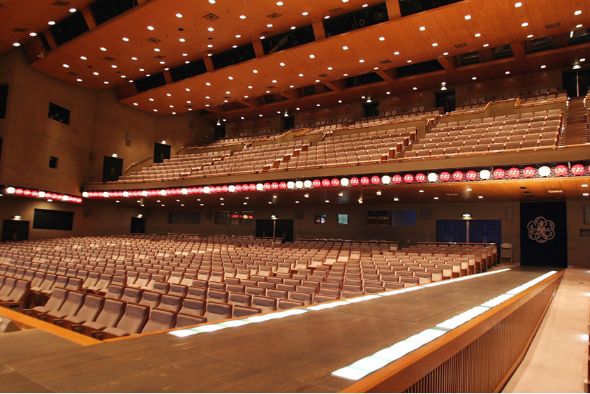Beguiled by Bunraku
Sophie Richard wanders around Japan
Words by Sophie Richard

Beguiled by Bunraku
One of the traditional performing arts of Japan, Bunraku is a sophisticated form of puppet theatre accompanied by music. Its origins date back to the early Edo period (early 17th century) and it gradually reached the style we know today about 300 years ago. On a recent visit to the National Theatre in Tokyo during a Bunraku performance, I was transported back to the heydays of Japan’s imperial court, in all its magnetic splendour.
The wonderfully convoluted historical plot, illustrating tales of heroism, intense jealousy between courtiers and an illicit love affair, could easily be followed thanks to the information provided in excellent English by the theatre. Equipped with a detailed synopsis printed in the brochure and a rental headset, I could immerse myself in the story and appreciate the formal elements of the performance thanks to the thorough commentary received in one ear as the intrigue advances. Bunraku is considered a serious art form and, unlike puppet theatre from other parts of the world, it tends to be enjoyed mainly by adults. I was pleased to see there were people of all ages in attendance.

At the start of the performance, puppets and puppeteers enter the stage. To the right, a secondary stage receives the narrator who not only chants the action but also speaks all the parts, altering his voice in sensational ways, and a shamisen player who accompanies him and sets the mood for each scene. Soon, the puppets movements become hypnotic and I almost forget that each one is being directed by three men who work silently in complete unison and in full view of the audience. The lead puppeteer wears formal traditional clothes while the other two are entirely clad in black fabric, including a hood covering their heads. Events unfold on stage and the puppets gestures express a range of emotions. Rather than merely mimicking human movements, a variety of distinctive poses forms the symbolic repertoire of sentiments on display: for example, a touch of the sleeve suggests romantic happiness. In Bunraku, there is a unique and subtle marriage between realism and artifice.


Afterwards, I am extremely lucky to meet one of the performers who patiently shows me how the puppets are handled and even let me try my hand at it! I am shown how the lead puppeteer operates the puppet’s head and the right hand, while the second one operates the left hand and the third is in charge of the legs. A puppet is made of wood and measures about 120 to 150 cm high. I quickly discover how heavy they can be (about five to ten kilos, which must be tiring to hold during a performance that can last a few hours). Directed by the master puppeteer, I slide my arm in the puppet’s sleeve he is presenting and try to move its left arm. Using a string with my two fingers I can animate four of the doll’s fingers in unison (the thumb does not move): its hands are mobile and expressive and, a bit clumsily, I try to replicate the greeting gesture the master is showing me. I can only imagine how challenging it must be to operate a doll along with two other performers standing so close to one another: the three men must carefully coordinate their movements to ensure that the doll’s gesture appear effortless, while respecting each other’s space.

Bunraku, along with Noh and Kabuki, ranks among Japan’s foremost stage arts and as such has been inscribed on the Unesco’s Representative List of Intangible Cultural Heritage of Humanity. I warmly encourage anyone to attend a performance on a visit to Japan: plays can be seen at the National Theatres in both Tokyo and in Osaka, the latter city being the actual birthplace of Bunraku. Its dramatic spectacle and aesthetic qualities continue to captivate audiences three centuries on.

National Bunraku Theatre
- Place
- 1-12-10 Nippon-bashi, Chuo-ku, Osaka-shi, Osaka 542-0073

For a more in-depth look at the world of Bunraku, visit the following website and attend a performance for yourself.
https://www2.ntj.jac.go.jp/unesco/bunraku/en/

